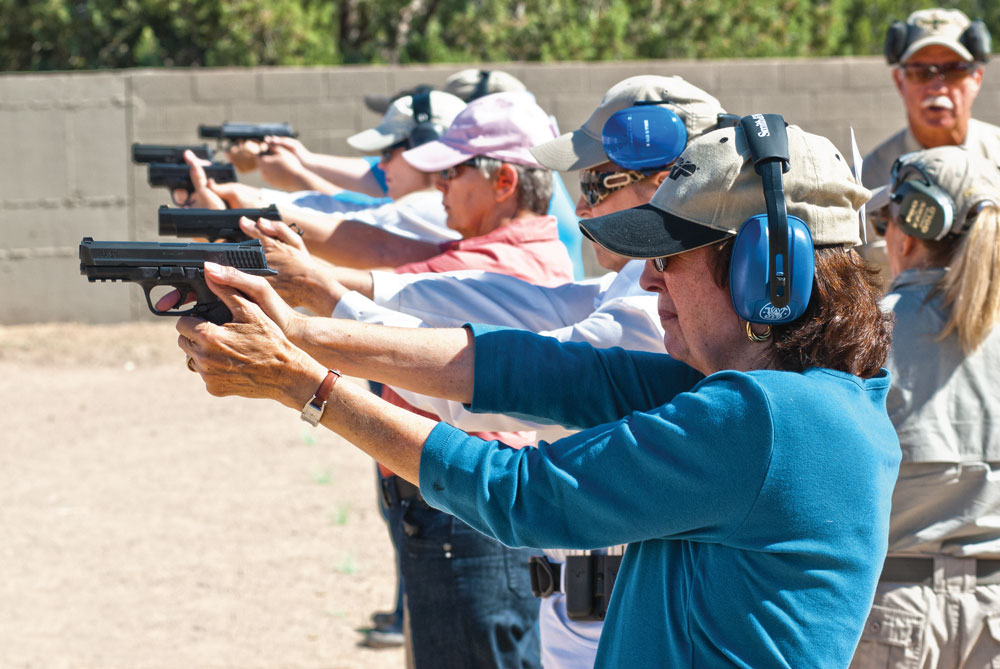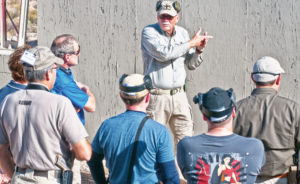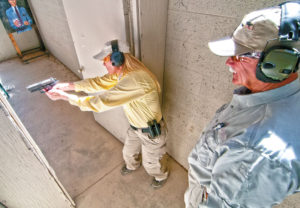
By Bob Whaley
There are many myths out there when it comes to proper defensive handgun training technique. Here, are seven of the most common debunked.
1. YOU WON’T USE YOUR SIGHTS IN A GUN FIGHT
I know; we have study after study, reams of empirical evidence and the commentary of really smart folks that say you will not use your sights under stress (Oh Lord, I hate that word). Most of the studies are based either on simulated gunfights under laboratory conditions or interviews with individuals involved in gunfights. In the case of the former, no simulation, no matter how carefully constructed, can exactly re-construct what occurs in real life. More on that later.
In the latter case, I’ve read lots of studies based on participant interviews, and with those supporting the “won’t-use-your-sights” theory, one thing always jumps out at me. We will accept that an individual will perform any number of actions without conscious thought as a result of deeply ingrained training leading to unconscious competence.
When, however, that same participant expresses any doubt about using the sights—an action they have performed literally thousands of times—the researcher will immediately conclude the sights were not utilized. If you accept that the shooter performs various actions due to ingrained training, why do we discount that phenomenon when it comes to using the sights? Could it be that the shooter used the sights and just didn’t register the action because it was so ingrained he performed it without conscious thought?

Well, I’ve done my own study. Thirty years of police work with 15 years on my department’s full-time SWAT team and (wait for it) two shootings. I know two is not a big number, but it’s a whole lot more than most of the researchers have experienced! And I used my sights in both instances. Friends of mine who have preformed well in shootings will say they performed well because they used their sights. We used our sights because we trained with outstanding instructors who demanded excellence. Then we obtained the experience to remain calm under pressure.
I will add one more thought on the use of sights in a gunfight. If you disregard your sighting system (iron sights, red dot or visible laser) and fixate on your target, you will most likely miss. I trained in instinct/unsighted/reflexive fire throughout the years, and it is impressive on a static range. History has shown, however, that unsighted fire leads to failure in actual shootings. Remember, the universal hit rate is 100 percent. A hundred percent of the time you launch a projectile down range, you will hit something.
Using the sights gives you the best chance of hitting your intended target and solving your problem. Fixating on the threat and blowing rounds somewhere down there ensures you’ll likely miss your intended target and hit an unintended target. That unintended target may be an inanimate object or a 4-year-old child. It’s your choice. Ensure success or accept failure.
2. FORCE-ON-FORCE TRAINING IS JUST LIKE THE REAL THING
No. Nope. No way! Don’t get me wrong. Force-on-force training is a vital category of training and, if done right, can give you a low-level base of experience—the final level of training. But force-on-force is not “exactly like real life.” How do I know? Remember those two shootings?
First, force-on-force training should be carefully constructed to validate training presented in the class. The training should provide you with all the answers. All you need to do is figure out the question during the exercise. Next, the best exercises are based on real world events, not the instructor’s imagination. Last, the instructor should not allow the exercise to descend to the level of a paintball game or allow the students to “stress out” (Man, I hate that word). Exercises should be carefully controlled so the student achieves all the needed training goals. But, to be clear, force-on-force is not “just like real life.”
3. YOU WILL RISE TO THE OCCASION
In fact, you will default to your level of training. Further, in a real event, your skills will likely deteriorate, at least in the initial encounter. You must have highly developed physical and mental skills to perform at a level that will ensure success. A fighting or combat mindset without the skills to back up that mindset is useless. Mindset alone is “talking the talk.”
Developing skills to back up your mindset is “walking the walk.” You have to have both. So many people in the defensive weapon craft community want to take short cuts in training. Go ahead, it’s only life and death. What is your life worth to you? Put in the work, and you won’t have to rise to the occasion. The occasion will have to rise to your level of competence, and you will have won before the fight even begins.
4. IT’S NATURAL/INSTINCTIVE
This comment is usually attached to the instructor’s favorite technique, position or method of performing a given act. With the exception of natural point of aim, there’s nothing about using a gun that’s instinctive or natural. It’s learned behavior.
You either learned it in a class, saw it on TV, heard someone talking about whatever it is you think came natural or you learned it by some other means. How do I know? I know because I make pretty good money teaching fighting arts, including use of a variety of firearms. If this activity was natural or instinctive, anyone of any age could shoot. They wouldn’t need to be taught; they would instinctively know what to do. It would be truly hardwired behavior.
Ask yourself: Did you know how to shoot before someone taught you? Of course not!
Shooting is learned behavior. You will learn, accept and perform what you believe is relevant to you and what you believe is valid. An instructor that explains everything by saying a given action is natural/instinctive either doesn’t know what he’s talking about or is too lazy to explain his training program. Either way, he’s shortchanging the student. The technique may be perfectly valid. But it’s learned behavior. Find an instructor who knows how to teach.
5. EVERYONE DOES THIS (INSERT INSTRUCTOR’S FAVORITE TECHNIQUE)

There are no universal actions in response to stimuli of any kind. How we react/respond is based on our individual experiences, training/education and perceptions. A couple examples come to mind.
Years ago, there was this popular idea that—when surprised—everyone would crouch down and square up to the perceived threat. Remember that thing about me being assigned to a full-time SWAT team for over 15 years? Well, my buddies and I thought about that. Want to see someone surprised? Knock down their door and burst through pointing guns at them, throwing flash bangs and yelling to get on the ground. Then you see what people really do when startled. Freeze in place, turn and run, assume a fetal position (lying, sitting or standing no less) but very few squared up to us because those were the ones that got launched, and very few got launched! Most people, after an initial shock, followed directions. The reactions to our induced shock were individual. Nobody did the same thing as the last guy.
The second example is the universal startle reflex, i.e. throwing up their hands in response to sudden stimuli. Ummm, ever been hit in the face by a fist, pillow, ball etc? Hands didn’t come up, eh? Let that happen enough, and you’ll get those hands up. Practice it enough, and throwing your hands up in a startle response indeed becomes ingrained. It can become ingrained to the point you may just do that instead of what is really needed in the moment like moving, going directly to your gun or deflecting an incoming punch or gun pointing at you.
You can build similar actions among a training population. That can be good or bad based on the nature of the instruction. Responses have to be based on the circumstances of the event. Broad-based skills are important, but you must be able to remain calm enough to select the right tool for the job. If you buy into the universal action myth, you may just find the universal action you had to be taught anyway doesn’t fit your problem. That means you’ve wasted time, and time is a commodity you don’t have in a life or death situation.
O.K., I admit, I’m a horrible person. I wanted to test this theory, so I used my 3-year-old granddaughter as a guinea pig. I took a sponge ball (not a baseball, so I guess I’m not too bad) and tossed it at her head. In response to that stimulus, she did not, in fact, perform a universal action of lifting her hands to protect her head. In fact, the sponge ball bounced off her head. She thought that was hilarious! It was a sponge ball! After several attempts and Pawpaw showing her how to get her hands up, she’s starting to get pretty good at getting her hands on the ball. Catching will come. She had to learn how to lift her hands to protect her head.
6. HEART RATE DETERMINES YOUR ABILITY TO PERFORM PHYSICAL ACTIONS
Ok, here’s an admission. Nothing I’ve stated so far is my original idea. I have read comments and counter comments to virtually all the myths presented here and compared the credentials of the commenters. Heck, bouncing the sponge ball (come on, it was just a sponge ball) off the granddaughter’s head wasn’t even my idea! So when this myth came up years ago, I was curious if it had validity.
I talked to doctors and a variety of trainers who both did and did not agree with the concept. The trainers were split just about 50/50 for and against the concept. The doctors, who included sports medicine specialists and cardiologists, all said the concept was without merit. I deferred to the docs, and this myth has pretty much been de-bunked over time.
The docs all indicated the same thing. If your heart beats too slow or too fast, it eventually stops working. Not good! That’s the only effect your heart has on performance. As long as your heart beats within a range that doesn’t adversely affect your health—in other words you die—you can pretty much do whatever you have trained to do. Pretty simple actually.
7. EVERYONE RESPONDS TO STRESS IN THE SAME WAY
Stress—Oh Lord, I really hate that word! This myth relates to myth #5 in that the proponents of this myth advance the idea that everyone will experience the same effects under stress (Oh Lord, oh Lord, I really, really hate that word). First of all, we all do not perceive the same things as stressful. Some folks can sleep soundly through the craziest of circumstances while others fall apart if their mail is late. Beyond perception, we are all wired differently in relation to our individual ability to manage stressful situations. Training and experience can help us manage critical incidents more efficiently, but on a virtual cellular level, some folks will just always do better than others in these situations.
Why do I hate the word stress so much? It’s a perfectly good word. It’s only six letters. It’s easy to spell. And it’s also so overused it has virtually no meaning left. Everything is stressful to someone. There’s no way we can say that any of us have universal responses to stress. Folks, simply put this one out of your mind. Might you be excited in a shooting? Yep. Might you wet your pants? Yep. Might you stand there and sling lead like you’ve done it everyday of your life and it’s a perfectly normal part of you day? Yep. And you won’t know exactly how you’re going to react in that situation until you’ve been there.
So, there they are. Seven myths I’ve encountered in my many years of training and engaging in the defensive application of firearms. Some are the result of well-meaning individuals attempting to explain something they just did not really understand or because they didn’t have the skills necessary to investigate the issue. Others have come about because someone was simply trying to differentiate his training program from another instructor’s. Either way, they are myths that absolutely get in the way of training proven over time in the hands of competent operators. If anything, I hope this information can help you avoid these myths and keep you from wasting your limited training time and money on non-productive concepts.
This article appeared in the November 2015 issue of Gun Digest the Magazine. Click here to download the full issue.
Also Check Out:
 Handgun Training – Practice Drills for Defensive Shooting
Handgun Training – Practice Drills for Defensive Shooting
Make your handgun skills combat-ready with the drills outlined in this handy little book. Nothing will give you more peace and security in your own home and on the street than the confidence you'll gain knowing you will hit your target. Get your copy
